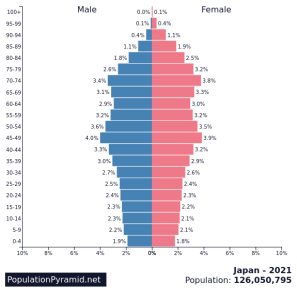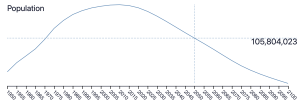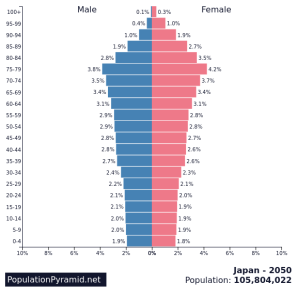Tackling Japan’s Unrecoverable Demographic Disaster
While the trend of an aging society is not exclusive to Japan and is experienced in many countries, Japan is the first G20 country to go through such a predicament on a massive scale. The costs of decline in the labor force will impact the economy, the country’s international stature and the ability to compete in foreign markets.

Retrieved from https://www.populationpyramid.net/japan/2021/
It is predicted that Japan will lose economic and political influence in the international arena if foreign professionals are not integrated into companies. (Crawford, 2021). A decrease in population also reduces the domestic market due to the lack of customers consuming products and workforce producing products. Technological advancement in digital technology and education alongside foreign national professionals’ influx is needed to save the economy.
Challenges that must be addressed by leadership in Japan:
- Who will work in Japan by 2050?
- Who will support the elderly when they outnumber all other demographics?
- What economic structure can reasonably support fewer workers and more elderly/incapable?
- How will Japan’s culture be kept alive with so few Japanese to do it?
Story A: Leadership Seminar
In my leadership seminars, I often ask dozens of senior Japanese corporate leaders attending in the room or lately, more often on the Zoom screen, the following question:
Imagine that you are being chased by a criminal 30 years from now in Japan, and you call the police for help. While you are running away from the violent criminal, you can finally see a police officer in the distance coming to your rescue. When the officer approaches, you can now see the clear image of your rescuer. Here I normally stop and let the audience imagine the scene. Then I continue.
Do you want this police officer to be a 78-year old Japanese police officer or a 24-year old Vietnamese-Japanese police officer?
Most of the audience remains silent, looking totally puzzled. They have never thought of such as scenario as possible in their future life.

(Retrieved from https://www.populationpyramid.net/japan/2050/)
A society cannot function properly when the majority of the population is over 65 and the minority under 40 without radical changes. By 2050, there will no longer be enough workforce to run the Japanese society. Trains and buses will no longer run so frequently or be on time. There will be not enough firefighters, self-defence force soldiers, and not enough police officers allocated to mini police stations (Koban) at every corner in the city. There will soon not be enough working-age population to sustain Japan’s once-deemed invincible quality, customer service, infrastructure, technology and social infrastructure. The vast majority of companies can not exist without workers and will disappear. Municipalities and local communities will wither away. Older people’s social welfare is too costly to stay at the same level and will come down sharply while young people’s financial burden to support older generations will skyrocket. Many ex-corporate employees will not BE ABLE to live on only their retirement allowance and a meagre national pension. Cities will be filled with old Japanese men and women hanging around unemployed and/or homeless and/or sick. Hospitals and unemployment offices will be jammed with desperate older people, and older people’s crimes and suicide will dominate the news every day.
Now you may think that is a very pessimistic view of the future. Still, if you put your emotion aside and just look at Japan’s disastrous demographic trend, it is very realistic that this very unhealthy society is awaiting us in the very near future. This is the sad result of Japan not seriously considering a proper immigration policy over the past several decades.
If you go to Germany, you can see many Turkish-German police officers. If you go to France, you can see many African-French police officers. Despite the recent far-right movements and growing tensions in the West, at least they are tackling the ageing population issues, and globalization needs head-on. On the other hand, Japan has always avoided the talk about immigration and still refuses to use the word “immigrants” in consideration of the national sentiment to keep homogeneity. Despite a clear need for a strategic immigration policy over the past 20 years, no politician or business leader seemed to have any sense of urgency. Even today, when the pessimistic yet very realistic future above is pitched to Japanese business leaders, the first reaction from most of them is, “I never thought about it!”. Somehow, the government and the media in Japan have been underplaying the issue of rapid population decline and rapidly ageing society. Understandably, the government doesn’t want to panic the public. Still, probably the real reason for underplaying this danger may be simply because most politicians and media people have never thought about it either, just as many business leaders often say.
It is shocking that most Japanese people, even those elite business leaders in large Japanese companies and graduates from elite universities, still seem to be unaware or indifferent or in the state of denial about the ongoing reality that their companies have so many vacancies they are unable to fill and the number of foreign workers is rapidly increasing. The overseas business is becoming the only promising revenue for survival. Many Japanese people are living as if nothing was happening around them. Most of them still do not make serious efforts to speak English, there are still so few female leaders and hardly any foreign leaders in Japanese companies, and most Japanese executives continue clinging to the same old Japanese rule books and counting the days until their happy retirement which will most likely be anything but happy, considering Japan’s demographic trend.
Only if you keep asking the Japanese leaders the same questions again and again with strong insistence about their own future, their family’s future and their company’s future with this unrecoverable demographic disaster of Japan’s next 30 years exploding in their faces, only then they eventually take it seriously and realize that they both as individuals and as companies can never survive unless they do something significantly different from what they have been doing for a long time.
As it is always the case, transformation happens with a strong sense of urgency. Japanese samurai leaders did not feel the need to open up Japan to the rest of the world in the mid 19th century until Commodore Perry came in black ships with big canons and opened up their eyes to what could happen to Japan if it had remained a feudal society. Today if we are truly observing what is happening in the Japanese community, we can clearly see many worrisome signs such as so many older people still working at construction sites or as taxi drivers, the mental illness spread throughout the corporate world, so many unhappy men and women never wanting even to date, trains more frequently stopping due to someone suddenly falling ill, so many children who are still studying all the time for the entrance exams sacrificing their childhood yet when they graduate from elite Japanese schools they don’t even have necessary English communication skills. Something is wrong. Something must be wrong. If we are honest and not escaping into the smartphone screen to be lost in cyberspace, our animal instinct must unavoidably tell us that something is wrong and Japan is going downhill. And this something is getting bigger and bigger year by year. Before we realize it, we will be all old people in this country, forsaken by the world, and it will be too late. Neither government nor companies could do anything about it anymore.
To mitigate this grim future forecast, we need to tackle the touchy subject of immigration courageously and face the fact that Japanese society can no longer be maintained by the Japanese alone. Japanese companies can not be of the Japanese, by the Japanese and for the Japanese anymore. For the very survival of the Japanese society and all the goodness in it, we need foreigners both as workers, customers and taxpayers of this country.

Retrieved from https://www.populationpyramid.net/japan/2050/
In 2050, when people under the age of 40 are a minority in Japan, the only way for Japan to survive is to have many young people with an international background. Vietnamese Japanese, Chinese Japanese, Korean Japanese, Indonesian Japanese, and also Western Japanese etc. We would call these future Japanese people “New Japanese.” As long as we objectively see our projected demographic pyramid, we have to kiss goodbye to Japan unless we have 25-35 million New Japanese. Many foreign academics and investors have been warning Japan about its imminent decline, including a well-known investor, Mr. Jim Rogers, who wrote in his book, “It is truly regrettable that Japan will disappear in the next 50-100 years.” Yes, he confidently predicts that Japan will disappear.
If we could successfully manage to bring in 25-35 million international people as New Japanese, Japan will look like a completely different country. Japanese schools will have a majority of students with an international background. At the coming of age ceremony, most of the new 20-year-old will be non-ethnic Japanese. Most recruits at Japanese companies will also be non-ethnic Japanese. It will be so diverse and international. It may be unthinkable to imagine such a future for Japan by looking at today’s Japan. However, unless we, the Japanese leaders today, start seriously discussing and preparing for such a future society, Japan will disappear with tens of millions of miserable older people who can not survive on their own, ultimately left behind, wondering around like Zombies on the land of the setting sun.
We have less than 30 years to face such a catastrophic reality in 2050. Hopefully, the Third Way Forum could drive a strong movement that wakes up the Japanese leaders to work with the international community in Japan to closely pave the way for a different, more optimistic and prosperous future.
